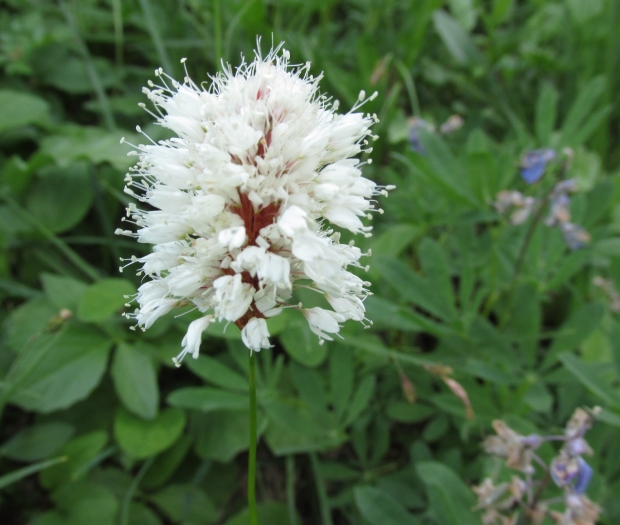American Bistort
(Bistorta bistortoides)
American Bistort (Bistorta bistortoides)
/
/

J Brew
CC BY-SA 4.0
Image By:
J Brew
Recorded By:
Copyright:
CC BY-SA 4.0
Copyright Notice:
Photo by: J Brew | License Type: CC BY-SA 4.0 | License URL: http://creativecommons.org/licenses/by-sa/4.0/ | Rights Holder: J Brew | Publisher: iNaturalist | Date Created: 2014-08-28T15:53:16-07:00 |

















Estimated Native Range
Summary
Bistorta bistortoides, commonly known as American bistort or western bistort, is a perennial herb native to moist meadows, streambanks, and alpine zones in the Mountain West, including regions from Alaska to California and eastward into the Rocky Mountains. This species thrives at elevations from foothills to above the timberline, often in areas with cool, wet summers. It typically grows 4 to 20 inches tall, with size diminishing at higher elevations, and features a clump-forming habit with leathery, mostly basal leaves. From late spring to early summer, it produces dense, cylindrical inflorescences packed with small white to pinkish flowers that are highly attractive to pollinators.
American bistort is valued for its resilience and low maintenance, making it suitable for native plant gardens, restoration projects, and as a ground cover in cool, moist climates. It requires consistently moist soil and can tolerate a range of light conditions from full sun in cooler climates to part shade in warmer areas. While it is not commonly afflicted by diseases, it can suffer from root rot if planted in poorly drained soils. The plant’s historical use by Native Americans as a food source adds an element of cultural significance, and it continues to support local wildlife, including rodents, bears, elk, and deer.CC BY-SA 4.0
American bistort is valued for its resilience and low maintenance, making it suitable for native plant gardens, restoration projects, and as a ground cover in cool, moist climates. It requires consistently moist soil and can tolerate a range of light conditions from full sun in cooler climates to part shade in warmer areas. While it is not commonly afflicted by diseases, it can suffer from root rot if planted in poorly drained soils. The plant’s historical use by Native Americans as a food source adds an element of cultural significance, and it continues to support local wildlife, including rodents, bears, elk, and deer.CC BY-SA 4.0
Plant Description
- Plant Type: Herb
- Height: 1-2 feet
- Width: 1-2 feet
- Growth Rate: Moderate
- Flower Color: Pink
- Flowering Season: Summer
- Leaf Retention: Semi-deciduous
Growth Requirements
- Sun: Full Sun, Part Shade
- Water: Medium
- Drainage: Medium
Common Uses
Bee Garden, Butterfly Garden, Groundcover, Low Maintenance
Natural Habitat
Moist meadows, streambanks, and alpine zones in the Mountain West
Other Names
Common Names: Smokeweed, Western bistort, Bistort Knotweed
Scientific Names: , Bistorta bistortoides, Bistorta bernardina, Bistorta bistortoides var. oblongifolia, Bistorta calophylla, Bistorta cephalophora, Bistorta glastifolia, Bistorta jejuna, Bistorta leptophylla, Bistorta lilacina
GBIF Accepted Name: